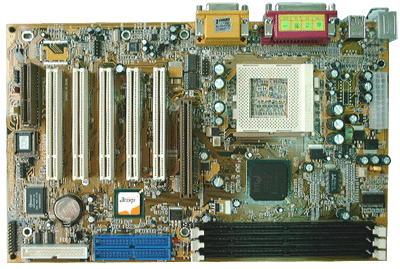

|
|


DOWNLOADS DRIVERS MANUALS BIOS Motherboards Mainboards HDD Harddisk IDE Cards Removable drives CD-ROM CDRW DVD-ROM DVD-RW DVD+RW Firmware Update Upgrade VGA Graphic Card Video Sound Sound Card Audio Soundcard Modem Modems ISDN Notebook Notebooks Laptop Laptops Monitor TFT LCD SCSI Adapter Printer Printers Plotter Multioffice USB Scanner Tape Backup Input Device Mouse Joyistick Digital Camera Camcoders Network Card LAN Wireless Wifi Adapter Adapters Card Cards Tests Diagnostics RAM Memory HDD Antispyware Remove Spyware adware...etc CPU Support Compatibility RAM Memory Support Compatibility VIRUS REMOVAL TOOLS |
6A815EP1 - ACORP 
Intel Socket 370, VIA C3 Processor, Intel 815EP (B Stepping), FSB 66/100/133 MHz, ATX, SDRAM, AC'97 Sound, AGP 4X, Ultra DMA 66/100, WOA, WOM, LAN on board -------------------------------------------------------------------------------- Chipset With the Intel® 815EP chipset, Intel delivers an external graphics solution for PC133/100 SDRAM platforms with all the performance, innovative features and proven reliability of the IntelR 815 chipset family. Pin-to-pin compatible with the Intel® 815EP ch FSB 100/133 MHz Frontside bus: the bus within a microprocessor that connects the CPU with main memory. The so-called dual independent bus (DIB) architecture allows a processor to use both this and the backside bus (which connects the CPU and the Level 2 cache) simultaneo SDRAM 100/133 MHz Synchronously DRAM :A memory technology that run synchronously to the system clock is capable of running at 100 or 133MHz ; it is more suitable to the high-speed memory and faster than conventional EDO memory. 2 Channel AC’97 Sound High-Quality Audio Versatile I/O Capability Cost Saving Power Management Driver/Software Support UDMA 66/100 Ultra ATA/100 - expected to be the final generation of Parallel ATA interface before the industry completes its transition to Serial ATA - was announced in 2000. Also referred to as Ultra DMA mode 5, the new specification uses the same 40-pin, 80-conducto Form Factor ATX The predominant motherboard form factor since the mid-1990s. It improves on the previous standard, the Baby AT form factor, by rotating the orientation of the board 90 degrees. This allows for a more efficient design, with disk drive cable connectors near PCI x 5 In its original implementation PCI ran at 33MHz. This was raised to 66MHz by the later PCI 2.1 specification, effectively doubling the theoretical throughput to 266 MBps - 33 times faster than the ISA bus. It can be configured both as a 32-bit and a 64-bi (IRQ's) to be shared. This is useful because well-featured, high-end systems can quickly run out of IRQs. Also, PCI bus mastering reduces latency and results in improved system speeds. AGP 4X Intel's release of version 2.0 of the AGP specification, combined with the AGP Pro extensions to this specification, mark an attempt to have AGP taken seriously in the 3D graphics workstation market. AGP 2.0 defines a new 4x-transfer mode that allows four l benefit wasn't seen until the implementation of 133MHz SDRAM and Direct Rambus DRAM (DRDRAM) in the second half of 1999. AGP 2.0 was supported by chipsets launched early in 1999 to provide support for Intel's Katmai processor. CPU Support Compatibility RAM Memory Support Compatibility Manufacturer - downloads drivers, manuals and BIOS : ACORP Prodejce v ČR : Možnost vložení odkazu prodejce - info zde Recenze : Odkazy na recenze vložíme po dohodě Problems, experience, griffs.....: |
|